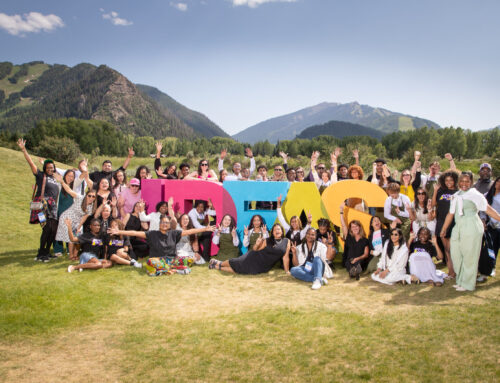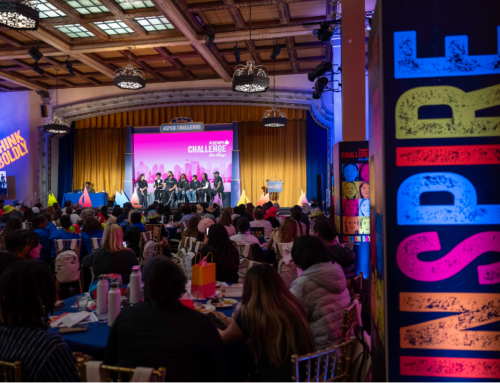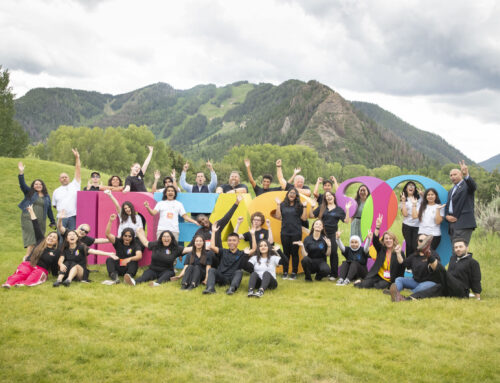Begin With Beauty
By Jane Golden
When you find yourself inside a Philadelphia school, as I often do, it’s easy to forget that you’re standing in a structure that was originally built for public education. It has the unmistakable feeling of a fortress, and the only word to describe your surroundings is gray. When you walk through the front entrance, you’re greeted not by smiling faces but by metal detectors and school-based police officers. You get rushed inside, as if you’re entering a locked-down facility.
With our organization, Mural Arts Philadelphia, I’ve spent decades bringing color and vibrancy to Philadelphia schools and, in turn, to the lives of talented kids. But this gloom-and-doom feeling still pervades the halls of many local learning institutions.
Sometimes I stop and ask myself: When did we decide, as a society and as a nation, that schools should feel like prisons?
And it’s not just the decor. There is often a punitive attitude that permeates school culture, in Philadelphia and across the country. Data collected by the US Justice Department during the Obama administration showed that students of color, students with disabilities, and LGBTQ students are disciplined more harshly than their counterparts in schools. Largely as a result of “zero tolerance” policies that mandate harsh punishments for even minor misbehavior, 3.3 million children are suspended or expelled each year — approximately double the rate of the 1970s. A student who has been suspended is more than three times as likely to drop out in the first two years of high school than a student who has never been suspended — and black and Latino students are more than twice as likely to drop out as their white peers. Students who drop out have more difficulty finding gainful employment and are more likely to spend years enmeshed in the criminal justice system.

Right now, in the wake of a high-profile school shooting, many Americans are asking themselves and each other about our priorities as a country. Are we going to invest in schools or prisons? Are we going to invest in a child’s future or a child’s failure?
I remember the day of the Parkland, Florida shooting well because it was the same day that I spoke to a group of young people participating in the 2018 Aspen Challenge Philadelphia about our country’s school-to-prison pipeline. I asked them: Did these statistics resonate, and if so, what could be done to make a difference? How could they act on their own behalf as young leaders, to become advocates for change?
Then I asked another big question: How could art be harnessed to address this critical issue that seems to stump most people in power?

The truth is, we all need beauty. It feeds and nourishes us. And I’ve seen the results, thanks to our work at Mural Arts. Our Art Education program, which serves over 2,000 students each year, has a 100 percent graduation rate among seniors in our open enrollment classes, compared to 65 percent citywide. The Guild, our paid apprenticeship program for previously incarcerated individuals and young adults on probation, helps reconnect participants with their communities through projects that bring beauty to local neighborhoods. Last year, 85 percent of Guild graduates found employment or moved into educational opportunities, and their recidivism rate was less than half the statewide rate.
I presented this challenge to these leaders-in-training because I believe in the natural correlation between art and social change.
Generations of creative makers and thinkers have employed music, paintings, technology, and other mediums to stir and inspire activism, and to raise awareness about oppression and injustice. Today, artists in Philadelphia and beyond have turned their attentions to a variety of issues such as climate change, race, gender inequality, and poverty.
The power of art is such that, when approached strategically, it can break through or transcend seemingly steadfast barriers to transform lives and bring about social reform. So, I asked these students: How do we consider an artistic approach to the school-to-prison pipeline? How could a creative campaign help to broker change?
An idea that begins with beauty often ends with new ideas and creative solutions around equity, opportunity, and access. I’m proud to say that five participating schools have taken up the challenge, and I can’t wait to see the brilliant ideas these students propose.





